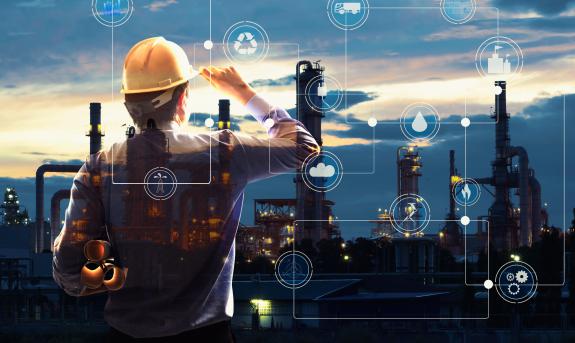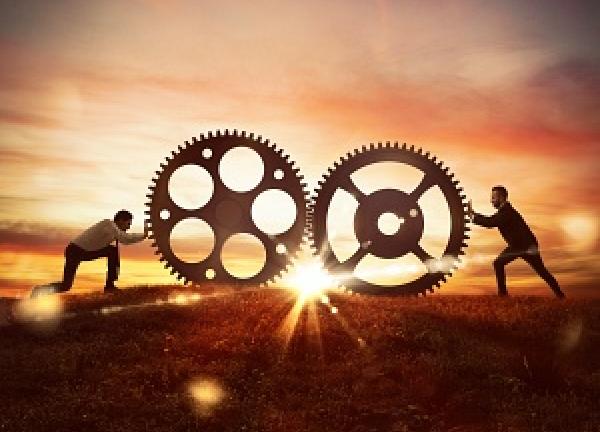Will the circular economy reinvent industry?
In view of the climate challenge and the need to preserve resources, the circular economy is no longer an option but a necessity and one that is accelerating transformation of the industrial world. But how can the factory of the future and circularity be sustainably integrated?

A grim milestone was reached on July 29, 2021, for that was “Earth Overshoot Day”, as calculated by the NGO Global Footprint Network*. In other words, the point this year at which humanity’s demand for ecological resources and services exceeded what Earth is able to regenerate this year. Yes, that’s right, we’re living on credit for five months and, if we continue on this misguided path, it will soon take three Earths to support us. Our stock of raw materials is finished, exhausted, increasingly scarce...
So what should we do? With COP 26 only just over, governments are sounding the alarm bells. They are all calling for increased awareness to move away from our linear economy – based on extraction, production, use and disposal – and towards a more resilient model. Europe is leading the way and aims to become the first “zero-carbon” continent by 2050, based on a fundamental theme – the circular economy. While the idea is not new, it has now found a new global resonance.
Ecodesign, reuse, recovery – the circular economy aims to cut the link between growth and the depletion of resources by creating sustainable goods and services.
A triple social, economic and environmental challenge
In general terms, the circular economy means producing goods and services in a sustainable way. With a three-fold objective: to preserve deposits of raw materials, to reduce the impact on the environment and to increase our individual well-being.
“According to the linear model, waste produced is sent to landfill or incineration,” explains Xavier Meyer, Circular Economy Leader at Saint-Gobain Group. “It is a model that wastes a lot of resources, unlike the circular economy, which aims to sharply limit the consumption of raw materials and non-renewable energies.”
In a context of global warming and dwindling resources, the circular economy responds to an environmental, economic and social challenge.
Firstly environmental, because this virtuous economy optimizes management of resources while minimizing greenhouse gas emissions.
Secondly economic, because circularity presents new value propositions, based on reuse, for example. Gone are the throwaway society and planned obsolescence. Nowadays we repair and reuse according to a sustainable economy approach.
Finally, social, since within countries, the circular economy creates local employment and promotes the emergence of new business opportunities.
Initiatives are flourishing everywhere and demonstrating industry’s ability to embrace a more frugal world. In the construction sector, Weber is working to replace sand with used materials such as foundry sand, demolition aggregates, etc. Some Saint-Gobain plasterboard factories already use more than 20% recycled gypsum from worksite waste in their products.
Placo®, meanwhile, is continuing its work to reduce the weight of its plasterboards and several countries have lightened their boards by more than 15%, with equivalent performance of course. The same thrift is being displayed by glassmakers, who are making their glass sheets thinner while maintaining the efficiency of the end product. Other manufacturers are developing innovative processes to recover as much of the product's intrinsic value as possible at the end of its life, including the French company Michelin, which processes its used tires by pyrolysis to produce a high-quality liquid fuel.
Strengthening regulations to help the circular transition
Yet despite all these good intentions on the part of industrial companies, the path to circularity sometimes seems a long one. Why? Simply because “thinking circular” requires a profound transformation in the way we innovate, produce, consume and manage products’ end-of-life. But also because the virgin raw material is frequently cheaper than the secondary material. This is due to the low cost and ease of landfilling in many countries. In the construction sector, accelerating and promoting deconstruction, rather than demolition, and encouraging sustainable market trends, such as lightweight construction solutions that consume fewer resources, are all means of promoting a circular economy. Given the wide diversity of regulations, “substitute resources” are managed at a national, regional or territorial level. For an international group, the issue will therefore be doubly complex in terms of legislation and practices, with each country imposing its own rules.

Processes to be adapted
For manufacturers, this particularly means designing products and systems that reduce the use of non-renewable raw materials, preserving long-term value and capable of capturing the value of the material at the end of its life cycle. This also requires the development of industrial processes that facilitate the reprocessing of end-of-life products. One example is glass wool. To be recycled in a glass furnace, it first needs to be reprocessed to remove the organic binder that holds it together. For plasterboard, the removal of paper will determine the ability to reintegrate high levels of recycled material. Finally, for PVC roofing panels, the obstacle to closed-loop recycling lies in the color pigments. This challenge calls for the development of appropriate solutions.
R&D therefore faces a huge task of testing and adapting compositions and adjusting certain processes, since the purity rate of secondary resources is unfortunately often lower than that of virgin resources.
In addition to this need to adapt industrial processes, it is interesting to examine the concepts of flexibility, modularity, adaptability and dismantling, in order to facilitate reuse, especially in the construction sector.
TO READ: “Are there any materials that can be infinitely recycled?”
A resilient and local economy
This reinvention of the industrial model lays the foundations for a profound cultural change, which needs to be built on a shared understanding of the issues, risks and opportunities. It is a far-reaching subject, which must be embraced by everyone, at both organizational and national level.
A creator of value and jobs, this resilience economy is the forerunner of a more modern and competitive industry. New players are emerging – transport, waste collection and processing companies – who are part of a “local GDP economy” with logistics that are closer to resources and customers.
Numerous challenges certainly still remain, because in many countries sorting waste at source is still not very widespread and landfilling remains a cheaper alternative than recycling... But faced with the vulnerability of supply chains and dwindling resources, the integration of circularity into industrial operations is on the right side of history, ensuring that the industry of the future is sustainable, resilient and helps to bring about a more virtuous economy.
*The study is based on three million items of data from 200 countries
Photos credits: Krunja/Shutterstock - CAPAPICTURES_C.ABAD/Medialibrairy Saint-Gobain



